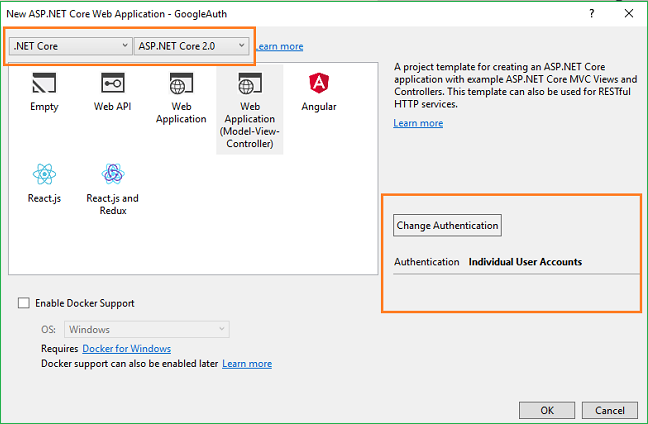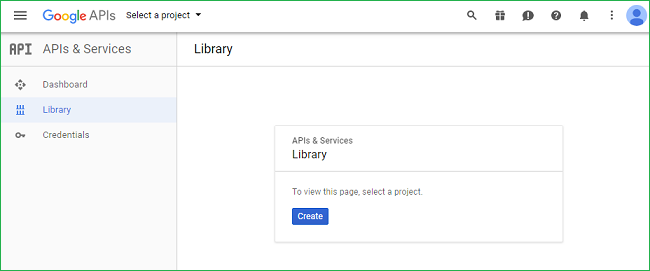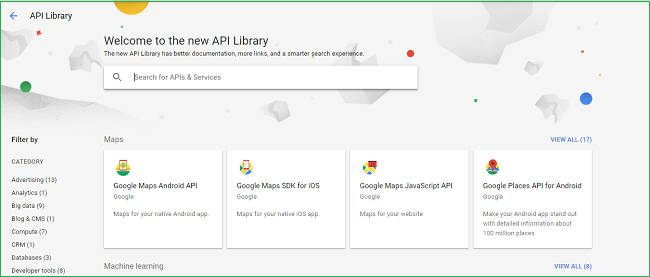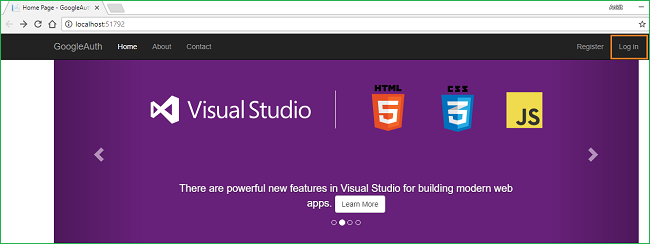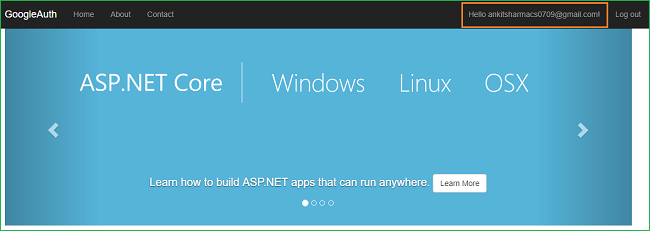ASP.NET Core 2.0: Authentication Using Google Account
Introduction
Sometimes, we want the users to log in using their existing credentials of third-party applications, such as Facebook, Twitter, Google etc. into our application. In this article, we are going to look into authentication of ASP.NET Core app using a Google account.
Prerequisites
- Install .NET Core 2.0.0 or above SDK from here.
- Install the latest version of Visual Studio 2017 Community Edition from here.
Create MVC Web Application
Open Visual Studio and select File >> New >> Project. After selecting the project, a "New Project" dialog will open. Select .NET Core inside Visual C# menu from the left panel. Then, select “ASP.NET Core Web Application” from available project types. Put the name of the project as GoogleAuth and press OK. Refer to this image.
After clicking OK, a new dialog will open asking us to select the project template. We can observe two drop-down menus at the top left of the template window. Select “.NET Core” and “ASP.NET Core 2.0” from these dropdowns. Then, select “Web application(Model-View-Controller)” template. Click on Change Authentication button, a "Change Authentication" dialog box will open. Select “Individual User Account” and click OK. Now, click OK again to create our web app.
Before running the application, we need to apply migrations to our app.
Navigate to Tools >> Nuget Package Manager >> Package Manager Console.
It will open the Package Manager Console. Put in Update-Database command and hit enter. This will update the database using Entity Framework Code First Migrations.
Press F5 to run the application. We can see a homepage, as shown below.
Note the URL from the browser address bar. In this case, the URL is http://localhost:51792/. We need this URL to configure our Google app which we will be doing in our next section.
Create Google app
We need to create a new Google app on Google API console. Navigate to https://console.developers.google.com/projectselector/apis/library and log in using our Google account. If we do not have a Google account, we need to create one. We cannot proceed without a Google account. Once we have logged in, we will be redirected to API Manager Library page, similar to the one shown below.
Click on Create button to move to “New Project” page where we need to create a new project. The “Project name” field will be populated automatically with a default name provided by Google. If we want then we can override that with our own custom name. For this tutorial, we will be using the default name. Accept the terms of service and then click on Create button.
Our project will be created successfully and we will be redirected to API Library page similar to one shown below.
Search for Google+ API in the search bar and select Google+ API from the search results. Refer to the below image.
After selecting the Google+ API option, we will be redirected to a page as shown below, where we need to click on the Enable button.
After this, the Google+ API will be enabled and we will be redirected to API home page. Click on "Create credentials" button on the right side of the page to configure the secrets for our API.
We will see an “Add credentials to our project” form.
This form has three sections.
Fill in the details of the sections as mentioned below:
Section 1 - Find out what kind of credentials you need
- Which API are you using? - Google+ API
- Where will you be calling the API from? - Web server (e.g. node.js, Tomcat)
- What data will you be accessing? - User data
And click on "What credentials do I need" button. We will be redirected to section 2
Section 2 - Create an OAuth 2.0 client ID
- Name – The default value provided by Google.
- Authorized JavaScript origins- Leave it blank.
- Authorized redirect URIs - Give the base URL of our application with "/signin-google" appended to it. For this tutorial, the URL will be http://localhost:51792/signin-google. After entering the URL Press TAB to add the value.
After this click on "Create client ID" button. We will be redirected to section 3
Section 3 - Set up the OAuth 2.0 consent screen
- Email address– Select your email address from the drop-down. This value is masked in the above image for privacy.
- Product name shown to users – Enter any product name. Here we are using “AuthDemo” as the Product name.
Important Note
Do not use the word "Google" in your product name. You will be prompted with an error and you won't be allowed to create the app. This means "GoogleAuthDemo" is an invalid name.
Click on continue.
Your credentials have been created successfully. Click Download to download a JSON file to your local machine with all your application secrets, and then click Done to complete the process.
Open the just downloaded client_id.json file and make a note of "ClientId" and "ClientSecret" field. We will need these values to configure Google authentication in our web app.
Configure Web App to use Google authentication
We need to store ClientId and ClientSecret field values in our application. We will use Secret Manager tool for this purpose. The Secret Manager tool is a project tool that can be used to store secrets such as password, API Key etc. for a .NET Core project during the development process. With the Secret Manager tool, we can associate app secrets with a specific project and can share them across multiple projects.
Open our web application once again and Right-click the project in Solution Explorer, and select Manage User Secrets from the context menu.
A secrets.json file will open. Put the following code in it. Do not forget to put your own ClientId and ClientSecret values.
{
"Authentication:Google:ClientId": "Your Google ClientId here",
"Authentication:Google:ClientSecret": "Your Google ClientSecret here"
}
Now open Startup.cs file and put the following code into ConfigureServices method.
services.AddAuthentication().AddGoogle(googleOptions =>
{
googleOptions.ClientId = Configuration["Authentication:Google:ClientId"];
googleOptions.ClientSecret = Configuration["Authentication:Google:ClientSecret"];
});
In this code section we are reading ClientId and ClientSecret for authentication purposes. So finally, Startup.cs will look like this :
using System;
using System.Collections.Generic;
using System.Linq;
using System.Threading.Tasks;
using Microsoft.AspNetCore.Builder;
using Microsoft.AspNetCore.Identity;
using Microsoft.EntityFrameworkCore;
using Microsoft.AspNetCore.Hosting;
using Microsoft.Extensions.Configuration;
using Microsoft.Extensions.DependencyInjection;
using GoogleAuth.Data;
using GoogleAuth.Models;
using GoogleAuth.Services;
namespace GoogleAuth
{
public class Startup
{
public Startup(IConfiguration configuration)
{
Configuration = configuration;
}
public IConfiguration Configuration { get; }
// This method gets called by the runtime. Use this method to add services to the container.
public void ConfigureServices(IServiceCollection services)
{
services.AddDbContext<ApplicationDbContext>(options =>
options.UseSqlServer(Configuration.GetConnectionString("DefaultConnection")));
services.AddIdentity<ApplicationUser, IdentityRole>()
.AddEntityFrameworkStores<ApplicationDbContext>()
.AddDefaultTokenProviders();
services.AddAuthentication().AddGoogle(googleOptions =>
{
googleOptions.ClientId = Configuration["Authentication:Google:ClientId"];
googleOptions.ClientSecret = Configuration["Authentication:Google:ClientSecret"];
});
// Add application services.
services.AddTransient<IEmailSender, EmailSender>();
services.AddMvc();
}
// This method gets called by the runtime. Use this method to configure the HTTP request pipeline.
public void Configure(IApplicationBuilder app, IHostingEnvironment env)
{
if (env.IsDevelopment())
{
app.UseBrowserLink();
app.UseDeveloperExceptionPage();
app.UseDatabaseErrorPage();
}
else
{
app.UseExceptionHandler("/Home/Error");
}
app.UseStaticFiles();
app.UseAuthentication();
app.UseMvc(routes =>
{
routes.MapRoute(
name: "default",
template: "{controller=Home}/{action=Index}/{id?}");
});
}
}
}
And with this, our application is ready.
Execution Demo
Launch the application and click Login in the top right corner of the homepage.
We will be redirected to http://localhost:51792/Account/Login page, where we can see the option to login using Google on the right side of the page.
Clicking on Google button will take you to the Google login page where you will be asked to fill in your Google credentials and authorize the Google app to use your Google account. After successful authentication from Google you will be redirected to a registration page inside our application where you need to fill in an email id to tag with your account. The Gmail id that you have used to login will already be populated in the Email id field. If you want to use another mail id you can change it here.
Click register, we will be redirected to the home page again but this time we can also see our registered email is in the top right corner.
Conclusion
We have successfully created and configured Google+ app and used it to authenticate our ASP.NET Core application. Download the source code and play with it to get a better understanding. Please note that secrets.json file contains dummy values. Hence replace the values with the keys of our Google app before executing it.
Source Code
Download the source code from here

